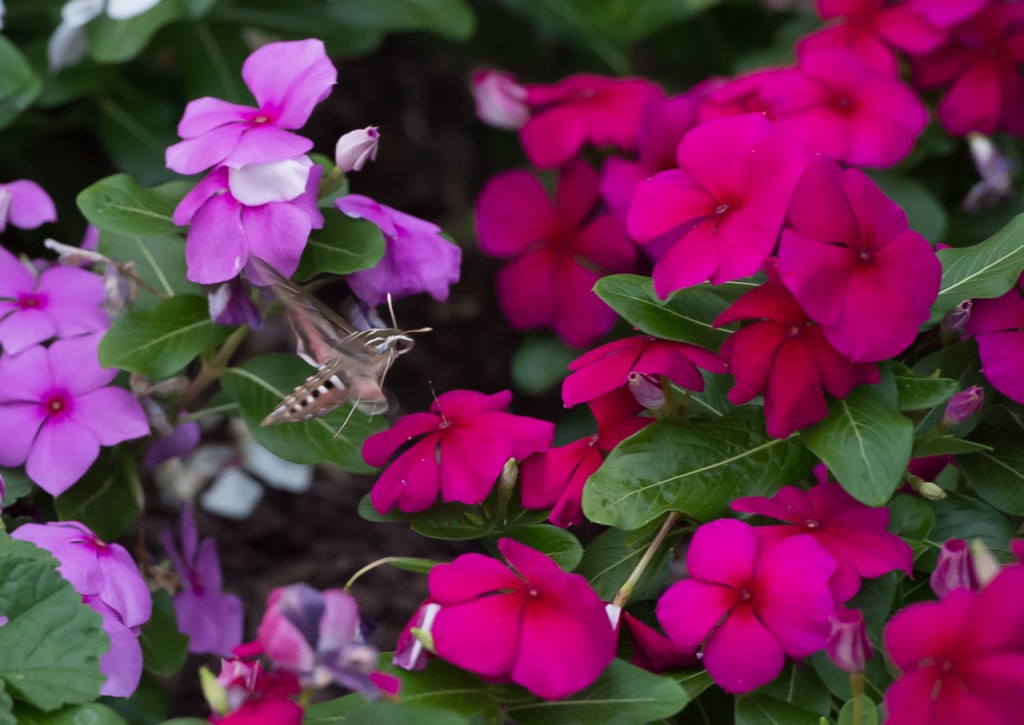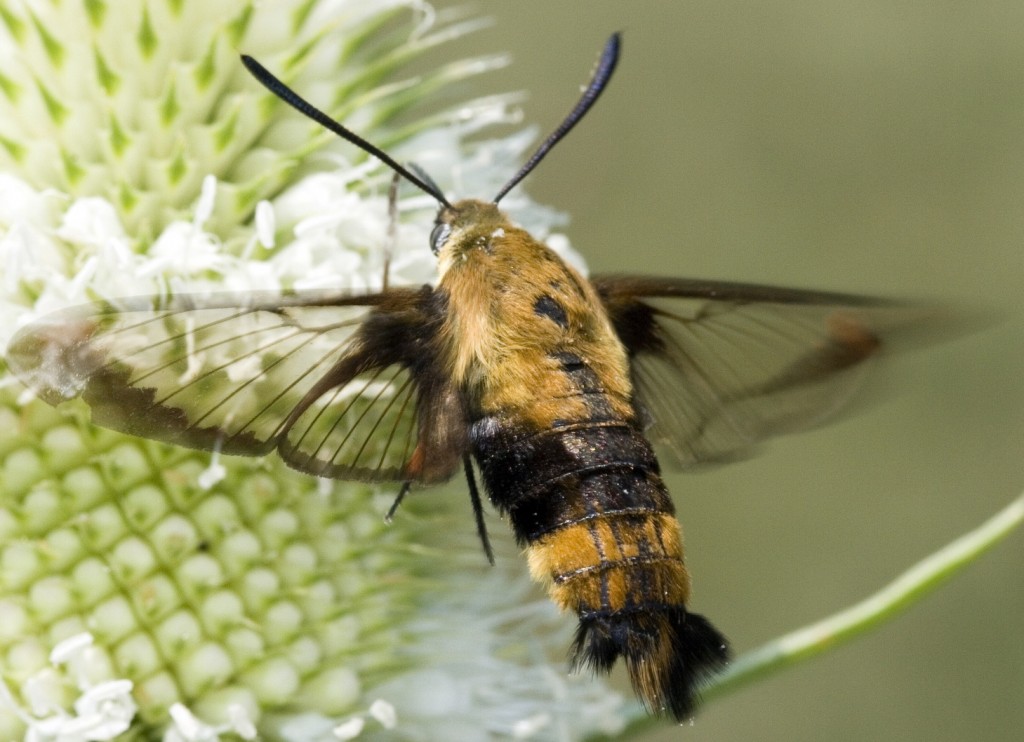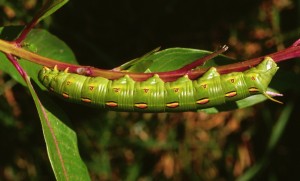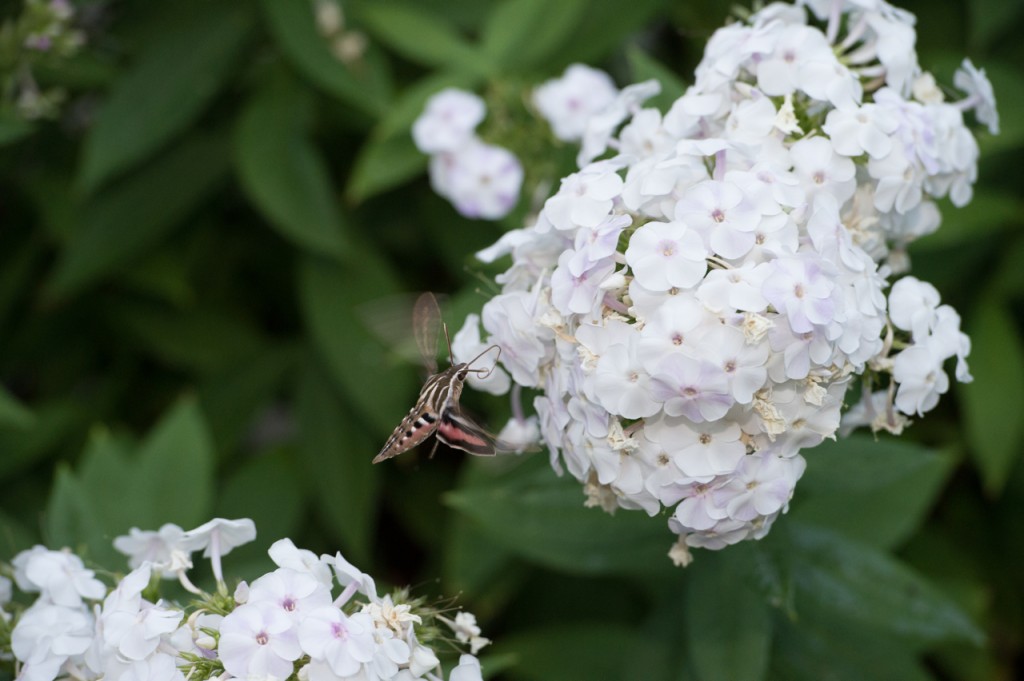Finding a Sphinx in Your Garden Makes for a Sight of Nature’s Beauty.

Not a hummingbird, this White-lined Sphinx moth nectars on garden flowers. Photo courtesy Tom Rollins, ThomasRollinsPhotography.com.
“I saw this really strange-looking hummingbird!”
“I saw this HUGE bumblebee!”
“The tomato bugs ate my garden!”
All three are related, but only to each other and not to hummingbirds or bumblebees. The hummingbird and bumblebee look-alikes are adult moths and the hornworms are caterpillars – the moth’s larval life stage — in the sphinx or hawk moth family, known in scientific nomenclature as Sphingidae.
Members of this family of moths can be found in all regions of the world. About 70 species are found in the Eastern U.S. out of the approximately 1,450 total species. Most are fairly large moths and are notable for their rapid and sustained flights; a few species even are able to hover-fly, one of the primary reasons these adults are nicknamed ‘hummingbird moths.’

A Hummingbird Clearwing sphinx moth can appear to be an oversized bumblebee. Photo courtesy David Cappaert, Michigan State University, Bugwood.org
The White-lined Sphinx (Hyles lineata) and Hummingbird Clearwing (Hemaris thysbe) are the two most commonly encountered ‘hummingbird moths’ of our area. Snowberry Clearwing (Hemaris diffinis) and Nessus Sphinx (Amphion floridensis) are the most commonly encountered ‘bumblebee moths’ seen here. All four are stout-bodied moths that are active during daylight hours. They can be viewed in forests and forest edges, gardens, and, as all are avid nectar drinkers, they often can be easy to observe as they sip from a wide variety of flowers.
Their behavior does resemble the hovering flight of hummingbirds, as both the White-lined Sphinx and Hummingbird Clearwing are able to move from side to side while hovering and feeding. Their long narrow wings and thick bodies along with sunlit flashes of color ranging from pink with greenish tinges also suggest hummingbird to the casual viewer.
Similarly, Snowberry Clearwing and Nessus Sphinx moths look like oversized bumblebees as they sport flashy window-paned transparent areas on black or brown edged wings, with bodies that look brown to black. Making the confusion with bees even more likely, in good light a Nessus shows two bands of bright bee-yellow color on the rear abdomen.

The hornworm caterpillar, in this case the larval form of the White-lined sphinx moth, feeds hungrily before entering the pupal stage and eventually metamorphosing into the adult stage. Photo courtesy Steven Katovich, USDA Forest Service, Bugwood.org
But the close observer can spot some telltale differences between these moths and the critters they are not. The moths all have a long proboscis for drinking nectar and all have a set of two antennae. Unlike hummingbirds, the sphinx moths don’t have beaks and hummingbirds certainly don’t have antennae. The bumblebee moths have longer antennae than bees, but the even easier give-away is that bees land on flowers and crawl inside blooms as they take nectar while the moths only will hover and dart.
While adult sphinx moths will nectar on a variety of plants, the caterpillars tend to be specialists, eating plant materials from a few hosts, and most often from plants within the same family. White-lined Sphinx caterpillars most often feed on plants in the evening primrose and apple/rose families; Hummingbird Clearwing caterpillars feed on viburnum and coralberry shrubs. While its name indicates a food preference, in our area the Snowberry Clearwing also feeds on coralberry, a common shrub of our bluff lands, closely related to the snowberry shrub native to western states. Both these shrubs and wolfberry, found in the northern half of Illinois, are members of the genus Symphoricarpus, and may be found in woodlands and disturbed areas. Caterpillars of Nessus Sphinx moths specialize on vines: wild grapes, the closely related raccoon grape plants and trumpet vines.

Another view of the hummingbird look-a-like. Photo courtesy Tom Rollins, ThomasRollinsPhotography.com
Nearly all Sphinx moth caterpillars have a horn or protuberance on the upperside of the rear of their body, giving the larval life stage its own general name of “hornworm.” These caterpillars can be rather active and will thrash about if disturbed. Several species are able to regurgitate sticky fluid, which, depending on the caterpillars’ host plant, can be toxic or at least bad tasting to a potential predator. It is the active stance of many of these caterpillars that gave the adult moths their common name of sphinx. Evoking the awesomeness of the Greek mythological winged monster of Thebes, with its lion’s body and woman’s head, the Sphinx often was depicted in a prone position with the head held high, seemingly willing to face any and all threats with no emotion. So, too, these caterpillars will rear their heads in a sphinx position to dare a predator.
In a vegetable garden that predator is often a human armed with a container of pesticide. Tomatoes, potatoes, tobacco, and, less frequently peppers and eggplants – all members of the solanaceae, or nightshade, plant family – may host caterpillars of either or both the sphinx moth species Tobacco (or Carolina) Hornworm (Manduca sexta) or Tomato (or Five-spotted Sphinx Moth) Hornwork (Manduca quinquemaculata).
The common names confuse the insect with their plant hosts, for Tobacco Hornworms, sporting an orange, pink or red horn, are much more likely to be found on tomato plants than are Tomato Hornworms, with their plain green horn. They can indeed do severe damage to tomato plants, for the caterpillars are voracious as they feed their way to a length of as much as 3 ½ inches before entering the pupal stage on their way to metamorphosis into an adult moth. As we might expect, the caterpillars are attractive to predators, including birds looking for juicy tidbits for growing nestlings, but, because these hornworms feed on nightshade family plants, birds may reject the taste.
Gardeners have additional allies, however. A type of wasp, known as a braconid (Cotesia congregata) lays eggs within the caterpillar that grow and feed. The doomed caterpillar host may endure for weeks as the wasp larvae tunnel their way to the outside and spin their own cocoon. Gardeners also can protect their primary tomato plants by planting some extra “decoy” plants at a distance and transferring hornworms to these. But, if a pesticide application is the only way for a gardener to raise healthy fruiting plants, their choice of a pesticide should be one that targets only the damaging hornworm caterpillar. Happily for gardeners, formulations of a bacteria-based pesticide, commonly sold as a “thuricide” compound do the trick, killing the hornworms, but doing no collateral damage to bees, butterflies, adult moths, or other insects. The active ingredient, Bacillus thuringiensis, works in the caterpillar’s gut by preventing the uptake of nutrients, resulting in starvation even as the caterpillar munches leaves. Thuricide compounds also may be used to treat cabbage-family plants to prevent the damage done by the caterpillars of Cabbage White butterflies, with, again, no harm done to other insects.
Summer brings juicy tomatoes ripening in warm sun and butterflies, hummingbirds, and bumblebees visiting flowers for nectar rich sips. Look carefully and you may glimpse something that looks like a hummingbird but isn’t. The sphinx in your garden, like the mythic creature of the ancient Greeks, could pose any number of questions to intrigue, challenge, and teach the observer about the awesome beauty of life.
CLIFFTOP, a local nonprofit organization, is focused on preserving and protecting area bluff lands.
A version of this article appeared in the 1 May 2015 edition of the Monroe County Independent.
© 2015 all content rights reserved Clifftop NFP
Comments are currently closed.
